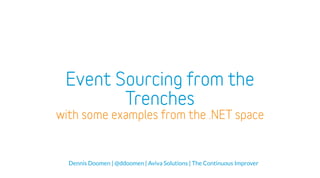
Event Sourcing from the Trenches (DDD Europe 2020)
- 1. Dennis Doomen | @ddoomen | Aviva Solutions | The Continuous Improver
- 6. Command Handlers Commands Domain Model Event Store Events App Query Store Data Access Projectors Events Query HTTP API Projections Events Command HTTP API Great unit of testing Great unit of testing Auditability comes for free Can look at the state in the past Can be scaled independently Autonomous projections Aligns well with Event Storming Forces you to understand your domain thoroughly No relational table structure anymore. Can replay old data against new rules More difficult to envisage domain relationships Great for replication
- 7. Application Command Service Correct Customer Email Handler Customer Unit of Work Projector Data Access Layer Read Database Write Database CorrectCustomerEmailCommand HTTP API / In-process invocation Get<Customer>(identity) Correct Email Event Store Load(events) Apply Get changes CustomerEmailCorrectedEvent Submit changes History Dennis Doomen | @ddoomen | The Continuous Improver NES Aggregates.NET SimpleDomain NStore EventStore NEventStore SQLStreamStore NStore NES Marten Handelier Brighter MediatR (*) Projac LiquidProjections (*)
- 8. Dennis Doomen | @ddoomen | The Continuous Improver Application Domain NoSQL / RDBMS OR/M / DAL Web UI, HTTP API, etc Lucene Index Document Projector Web UI, HTTP API, etc Web UI, HTTP API, etc Domain Commands Events Event StoreProjections Projectors Uses Event Sourcing Uses traditional CRUD architecture Indexing-based architecture Subcribe to webhooks Coarse- grained HTTP requests. Bus Subscribe Publish coarse- grained event
- 9. Customer #123 Correct Customer Shipping Address Command Customer Shipping Address Corrected Event Event Store Treat as a message, not a type Order #456 Correct Shipping Address Command Handler Application Customer Shipping Address Corrected Handler Order Redirected Event. Identity != natural key Identify partition key Primitive types only Avoid terms like Create, Update, Delete, Change. Avoid property change events Don’t use as inter-domain contracts Don’t expose outside the domain Dennis Doomen | @ddoomen | The Continuous Improver
- 10. Customer #123 Correct Customer Shipping Address Command Customer Shipping Address Corrected Event Event Store Order #456 Correct Shipping Address Command Handler Application Order Redirected Event Dennis Doomen | @ddoomen | The Continuous Improver
- 11. Command Service Some Command Handler Customer #123 Event Store Customer Created Event Get<Customer>(“123”) Customer Created Event Converter Customer Enrolled Event May split or merge events Can also run as part of migration May change the identity Unaffected Events Dennis Doomen | @ddoomen | The Continuous Improver
- 12. Event Store Projector Projector RDBMS Subscribe Subscribe Document DB Projector RDBMS Subscribe Raw SQLNHibernate RavenDB Lookup Autonomous & independent Storage technique optimized for projection No joining of projections Avoid reusing the projections for multiple purposes Use aggressive caching during rebuilds. Caching strategy optimized for projector Owned by projector Dennis Doomen | @ddoomen | The Continuous Improver Stream-by-stream projections during rebuilds
- 13. var mapBuilder = new EventMapBuilder<MyContext, DocumentProjection, string>(); mapBuilder .Map<WarrantAssignedEvent>() .AsCreateOf(anEvent => anEvent.Number) .Using((document, anEvent) => { document.Type = "Warrant"; document.Kind = anEvent.Kind; document.Country = anEvent.Country; document.State = anEvent.InitialState; }); mapBuilder .Map<StateTransitionedEvent>() .When(anEvent => anEvent.State != "Closed") .AsUpdateOf(anEvent => anEvent.DocumentNumber) .Using((document, anEvent) => document.State = anEvent.State); Dennis Doomen | @ddoomen | The Continuous Improver
- 14. Transaction Event Event Transaction Event Event Transaction Event Event RDBMS INSERT/UPDATE … WHERE … Transaction Event Event Transaction Event Event Transaction Event Event RDBMS INSERT/UPDATE … WHERE … INSERT/UPDATE … WHERE … INSERT/UPDATE … WHERE … Unit of Work Dennis Doomen | @ddoomen | The Continuous Improver
- 15. private async Task<ExceptionResolution> OnException(ProjectionException exception, int attempts) { if (IsTransient(exception)) { if (attempts < 3) { await Task.Delay(TimeSpan.FromSeconds(attempts ^ 2)); return ExceptionResolution.Retry; } return ExceptionResolution.Abort; } else { if (exception.TransactionBatch.Count > 1) { return ExceptionResolution.RetryIndividual; } // Mark projection as corrupt return ExceptionResolution.Ignore; } } Dennis Doomen | @ddoomen | The Continuous Improver
- 16. Event Store Projector Subscription Projection Subscribes to events from multiple aggregates Lookup
- 17. Event Store Other Projector Lookup Projector Subscription Subscription Storage (persistent) Lookup Event Modifier Modifies events with lookup data Receives extended events Dennis Doomen | @ddoomen | The Continuous Improver
- 18. var stats = new ProjectionStats(() => DateTime.UtcNow); stats.StoreProperty("CountByDocument", "some setting key", "some value"); stats.LogEvent("CountByDocument", "some significant thing that happened"); stats.TrackProgress("CountByDocument", currentCheckpoint); float? transactionsPerSecond = stats.GetSpeed("CountByDocument"); TimeSpan? eta = stats.GetTimeToReach("CountByDocument", targetCheckpoint); public void Configure(IAppBuilder builder) { builder.UseStatistics(stats); } Dennis Doomen | @ddoomen | The Continuous Improver
- 19. IAppBuilder builder = …. builder.UseStatistics(stats); GET http://localhost/projectionStats/CountByDocument { "projectorId": "CountByDocument", "lastCheckpoint": 1000, "lastCheckpointUpdatedUtc": "2018-05-10T10:39:00Z", "properties": [{ "key": "some setting key", "value": "some value", "lastUpdatedUtc": "2018-05-10T10:39:00Z" }], "eventsUrl": "http://localhost/projectionStats/CountByDocument/events" } Dennis Doomen | @ddoomen | The Continuous Improver
- 20. Document #1 Created Event Event Store Graph Projector Document #1 Closed Event (other events) Projector with active projections Archiving Projector Start archiving Document #1 Marked As Archivable Event Mark all events as archivable Tracks dependencies between documents Deletes projections related to Document #1 Can skip all archivable events during next rebuild. Dennis Doomen | @ddoomen | The Continuous Improver
- 21. Event Store Lucene Projector Document #1 Marked As Archivable Event Allows projectors to clean up Lucene Index Take snapshot Purge events Tombstone $tombstone stream Application Document Projector Search. Tracks deleted streams for future references Stream Tombstoned Event Search Dennis Doomen | @ddoomen | The Continuous Improver
- 22. Event Store Projector Application Version 2 Owns schema (e.g. FluentMigrator) Version 1 X Involves down-time until projections are rebuild Dennis Doomen | @ddoomen | The Continuous Improver
- 23. Event Store Projector Application Application Network Load Balancer Event Store Version 1 Version 2 events Projection ProjectorProjection bring off-line Returns HTTP 503 (Service Unavailable) Dennis Doomen | @ddoomen | The Continuous Improver Returns HTTP 503 (Service Unavailable)
- 26. Dennis Doomen | @ddoomen | The Continuous Improver
- 27. Dennis Doomen @ddoomen Dennis Doomen | @ddoomen | The Continuous Improver
- 28. • The Good, The Bad and the Ugly of Event Sourcing https://www.continuousimprover.com/search/label/event%20sourcing • Effective Aggregate Design (Vaughn Vernon) http://dddcommunity.org/library/vernon_2011/ • Liquid Projections https://www.liquidprojections.net • Distributed Event Sourcing (Slides) https://www.slideshare.net/dennisdoomen/building-occasionally- connected-applications-using-event-sourcing • Data schema changes in an event sourced system (paper) https://files.movereem.nl/2017saner-eventsourcing.pdf
